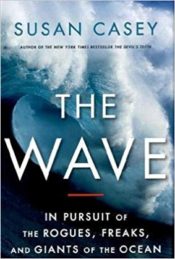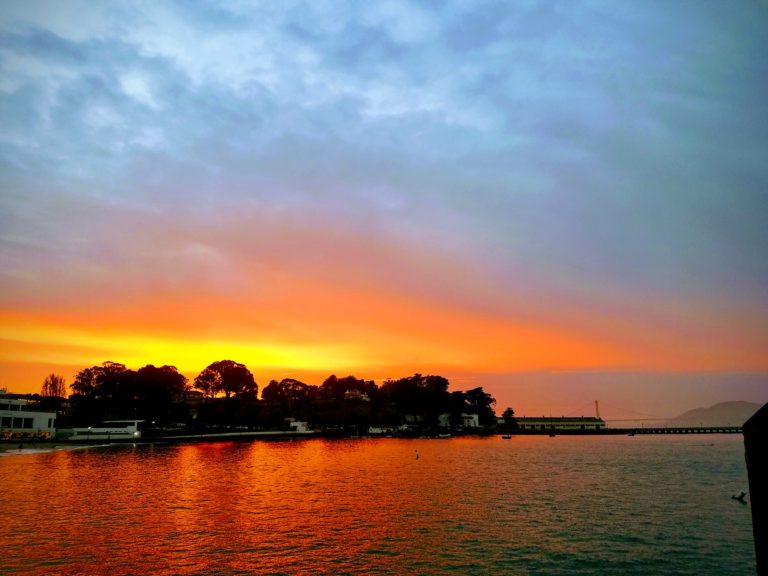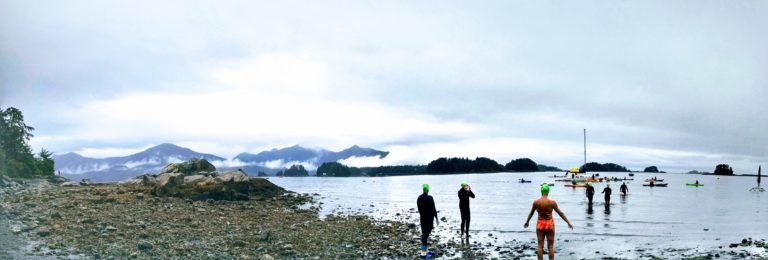Susan Casey’s The Wave is a story that will make you think about how changes in the world’s oceans have far reaching effects while leaving you amazed and terrified.
Casey approaches the story of giant waves from the perspectives of cutting edge surfers, the shipping industry, and scientists, successfully telling the global story of how increasingly large and frequent giant waves affect human civilization, as well as what it is like to be around those waves and feel that power. The waves Casey writes about are orders of magnitude larger than the waves I watch at Ocean Beach and she writes of these waves with a reverence that would have been easy to avoid. This reverence is what made this book come alive for me. I hope to never unexpectedly see a giant wave in my life but her description of the raw power unleashed by these waves has given me even more respect for the ocean.
I opened this book expecting the scientists to be the prominent storyline but as I read it I began to appreciate her use of the surfers as the main story tellers. It is really hard to explain the power of the ocean to someone who has never been in it; as someone who spends a lot of time in San Francisco Bay and on the beaches of Northern California I am better informed than most about the power of the water but I have no frame of reference for the giants she is writing about. While trying to learn what these waves are like she realizes that most of the scientists studying these waves have no interest in going anywhere near them; the mariners go through these seas out of necessity, but the surfers seek them out.
Giant waves were thought to be anomalies or the tall tales of frightened shipwreck survivors until recently. Science said they shouldn’t exist. Casey rattles off oil platforms and ships that were taken out by waves that should never have existed according to the scientists and engineers that helped build them. The surfers and mariners in this book came to their knowledge of the ocean via the old ways, of watching and studying and feeling the water. Although these ways can be written off as not very scientific by those too analytically minded, these watermen know the waves better than anyone. The scientists are now figuring out how to explain waves that the surfers and mariners know intimately. Science would have said a 1700ft wave was impossible, yet 4 of the 6 people in Lituya Bay survived it partly due to luck and partly due to understanding how to navigate an angry ocean.
Despite watching the cargo ships cruise in and out of the Golden Gate, I know very little about shipping. Casey states that lost cargo ships and near misses tend to be kept quiet and rarely make the news. We learn that older ships, meant to last roughly twenty years, are being pressed into longer service. These ships were not built to withstand giant waves because back when the ships were built science said these giants didn’t exist. These older ships are staying in service longer due to increased demand in global shipping. The increased demand in shipping is also happening while experienced crews are leaving the industry. She writes that the oceans are full of old ships run by inexperienced crews and the water is only getting rougher. She points out that although the number of lost ships may not be increasing, the newer giant ships are equivalent to two older ships so a loss of one carries the same damages as losing two ships twenty years ago. These losses can leach chemicals and oil into the oceans, ruining down current ecosystems.
One afternoon, while reading about Mavericks, a wave that is not far from my house, I had to put the book down and go surfing (nowhere near Mavericks). I hadn’t been in awhile and I’m a terrible surfer but I love going out and getting beat up a little bit. It reminds me that I’m not very big in the grand scheme of things and that reminder helps put most of my problems into perspective. I went out in 4-6ft waves that were pretty sloppy and just kept rolling in with no clearly defined sets. It probably took me 15-20 minutes to paddle 50 yards out. As I sat out there resting up I thought about the athleticism required to surf these 70ft waves. Every time I go to the beach, and Northern California beaches tend to be a little rougher than the postcard perfect beach, I think about how much stronger the ocean is than me. Through the surfers’ stories Casey informs her readers that the ocean must be respected and there is no place for arrogance around big waves.
I’ve written about fear quite a bit and I believe that fear isn’t something to be avoided, but rather, something to listen to and use as a guide to grow. Casey talks to the surfers about how they must be fearless to go near these waves. The surfers make it clear that these waves are terrifying and that they have a healthy fear of the ocean. The surfers study the waves and learn their intricacies and they grow to respect the wave.
“Fearlessness is ignorance, and it’s a lack of respect. Fear is powerful. You get a lot of energy from fear. Without fear, humans wouldn’t have survived. Maybe I’m the most scared.” – Laird Hamilton
The Wave
I recommend this book to readers who are interested in the ocean, coastal communities, shipping, or weather. It’s well written and accessible to a non-technical audience as well as those who are not familiar with the big waves of the world. The book reads easily but contains quite a bit of information so while it could be a quick read, I’d suggest taking a little more time to soak it in and do some research on the events Casey touches on. I definitely spent several hours watching youtube videos of big wave surfing while reading this just to get a better feel for what I was reading about.



